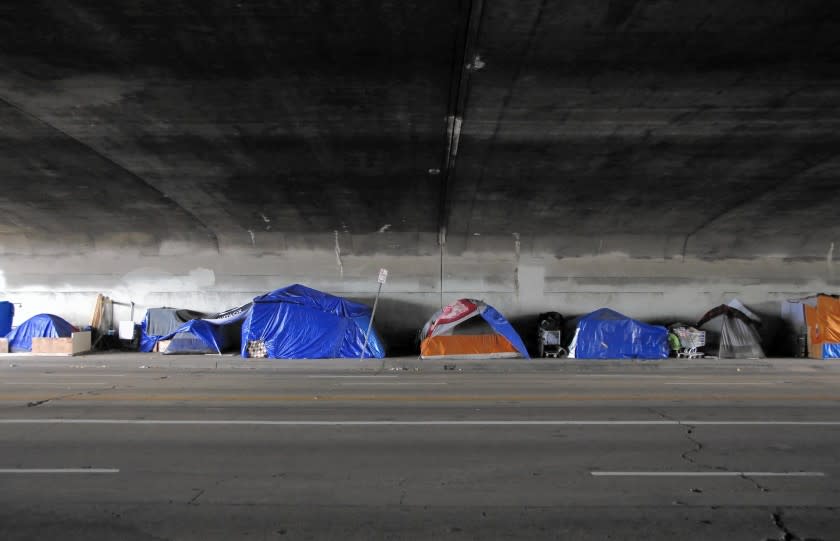Editorial: Pushing encampments away from bridge shelters does not make homelessness go away

Homeless encampments have mushroomed across the landscape of Los Angeles — a testament to the alarming year-over-year increase in the homeless population, the severe lack of affordable housing and the city’s failure to find housing for everyone who, through some combination of poverty, bad luck and personal demons, ends up on a sidewalk. Even after the city finishes building the permanent supportive housing to which it has committed more than a billion dollars, there will simply not be enough to go around.
None of that is a revelation. City officials have been grappling with these intractable problems for years. That’s why it’s both disheartening and infuriating to see them try yet again to figure out a way, not to create more housing, but to ban people from living on sidewalks — or in this case, certain sidewalks.
This week, the L.A. City Council is expected to consider whether to have City Atty. Mike Feuer draft a new ordinance that would ban homeless encampments within 500 feet of the nearly two dozen shelters created as part of Mayor Eric Garcetti’s A Bridge Home program. It would also ban obstructing the public right-of-way on a sidewalk, in compliance with the Americans with Disabilities Act. And it would ban camping within 500 feet of a freeway overpass, ramp, or tunnel.
This proposal is intended to placate two audiences. One is the council members' constituents who are weary of city sidewalks chock-a-block with tents and strewn with trash. The other is U.S. District Judge David O. Carter, who ordered the city and county in May to move several thousand homeless people out from under or near the freeways that crisscross the county. He withdrew his order when city and county officials agreed to work together to house people who have camped near freeways.
The restrictions on encampments near shelters and freeways wouldn't be unreasonable if there were much more housing available and much less coronavirus. Two and a half years ago, when Garcetti proposed a program of at least one bridge shelter in each of the 15 council districts, he told residents that if they accepted the shelters — which are intended to draw homeless people from the neighborhood — he would make sure the immediate area around them would be cleaned regularly and that no further encampments would be allowed nearby.
That has been a difficult promise to keep. There were never enough beds in all the bridge shelters to come close to housing every homeless person on the street. There aren’t enough beds in all the shelters in the city to house everyone who is homeless here.
Then came the COVID crisis. Public health guidelines recommend that homeless people in camps not be dispersed unless they can be offered individual shelter or permanent housing. Certainly, leaving homeless people in place — or moving some of them into the several thousand hotel rooms the city and county were able to provide, temporarily — coincides with an unexpectedly low incidence of COVID-19 among homeless people. Among some 66,000 homeless people in the county of Los Angeles, there have been 1,979 cases confirmed to date. Of those cases, 1,074 were among people staying in shelters. An additional 654 were unsheltered, and 251 had an unknown shelter status. There have been 47 deaths.
All those reasons are why many homeless encampments have been left alone. Nothing has changed in the circumstances to warrant shooing people away from where they are camped when there is no safe alternative offered.
As demanding as constituents can be, Judge Carter is probably considered even more so by council members. To please Carter, city officials have agreed to prioritize sheltering homeless people living under freeways. Homeless people near freeways will be offered shelter, and only if they refuse will they be ordered to relocate. But as we have said before, no matter how well-intentioned Carter’s directive, he should not be deciding who gets priority on shelter in the city. In fact, people often seek freeway underpasses to escape the rain or the heat. The city should not be banning these rare spots of refuge on the street.
City officials are still trying to increase the supply of housing for homeless Angelenos, including setting up so-called tiny homes, reserving parking lots where homeless people can stay safely in their vehicles, and acquiring motels and hotels. All those are great ideas. Los Angeles needs to get a critical mass of these kinds of arrangements in place before crafting a new ordinance that banishes people from their camps when they have nowhere else to go.
This story originally appeared in Los Angeles Times.

